Hey, hitchhikers?

Walking backwards with thumbs extended?
Hop in and ride shotgun while we take a spin:
Because in the wonderfully weird and occasionally nonsensical world of pop culture, the cars, buses, and even the odd spaceship aren’t just hunks of metal. Nope – they’re practically living, breathing (or at least heavily carbureted) characters.

Arguably, sometimes with as much personality as the actual humans involved.
So buckle up, buttercups, and let’s hit the road – and have a drive-by look at…
The Monkeemobile – The Monkees (1966)
This wasn’t just a car; it was practically the fifth Monkee.
It zoomed along and aside the madcap adventures of the Prefab Four like a caffeinated bumblebee, probably racking up more screen time than some of the bewildered guest stars.
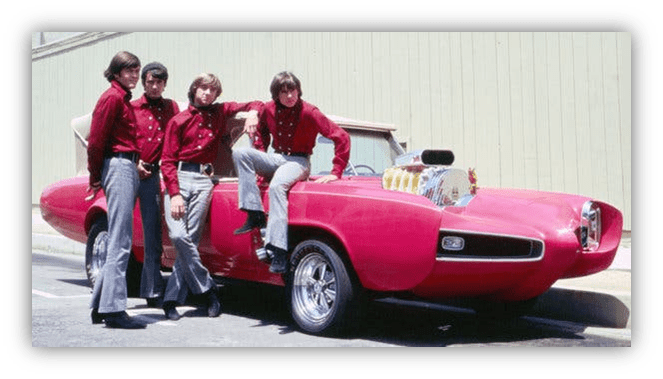
A 1966 Pontiac GTO that underwent a truly unique transformation courtesy of designer Dean Jeffries, it practically screamed, “look at me!”
You could spot this wild ride a mile away, especially whenever the perpetually charming Davy Jones was behind the wheel. Likely serenading an adorable yet bewildered bystander.
The Beatles’ Magical Mystery Tour Bus (1967)
The Beatles’ Magical Mystery Tour movie project, conceived largely by Paul McCartney, was a loosely scripted, psychedelic television film.
The concept: “What’s say we go on a whimsical holiday bus tour with really strange characters experiencing surreal adventures?” And as the panning critics of the time duly noted: that was about it.
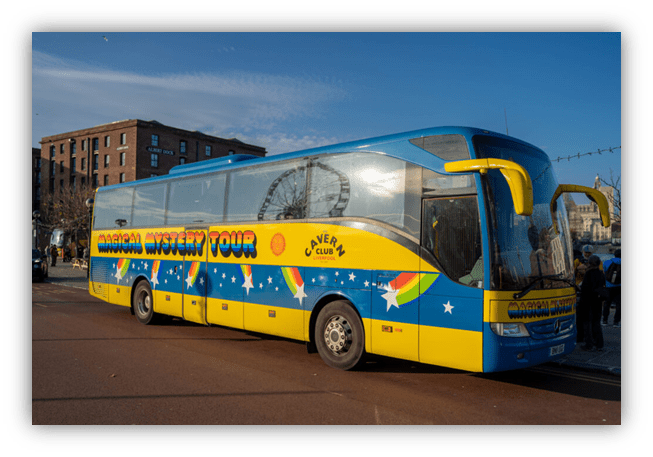
Front and center of the madness was a garishly painted Plaxton Panorama I luxury coach.
(And as a public service for all of you Apple Scruffs: just so that you can dazzle everyone at your next fan-fest, we’re pleased to provide the answer to a ridiculously obscure Beatle trivia question:)
“URO 913E.”
You’re welcome.
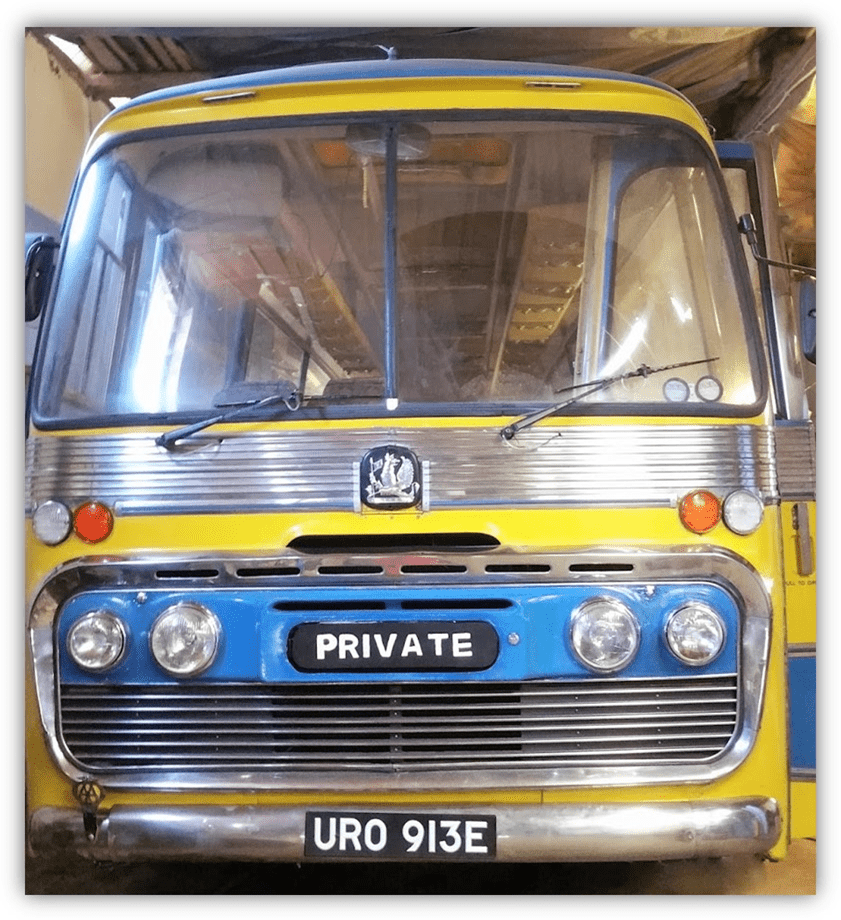
Doused in psychedelic hues, the bus looked like someone had spilled a rainbow and then decided to drive it around. It was used for the project to visually embody the whimsical and… um… “substantive” nature of their post-Sgt. Pepper’s Lonely Hearts Club Band era.
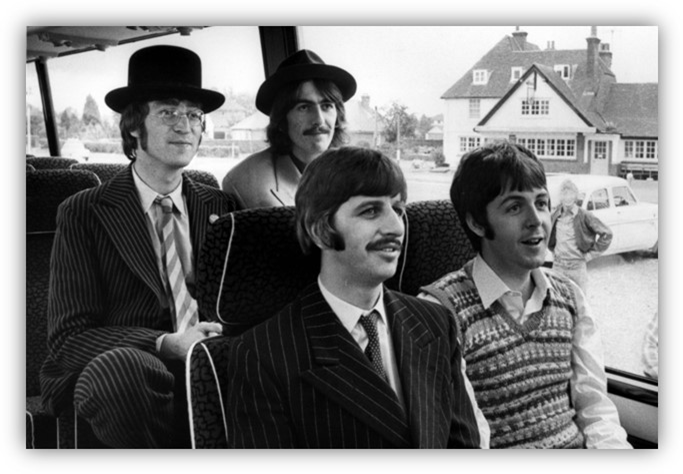
It ferried our favorite Liverpudlians and a cast of offbeat friends through what can only be described as a surreal mental landscape.
The only ticket to ride required was a healthy dose of imagination. And, I guess, maybe a tambourine.
The Partridge Family Bus – The Partridge Family (1970)
This is what you get when a 1957 Chevy school bus escapes from a particularly vibrant art class.

Painted in Mondrian-esque blocks, this rolling masterpiece transported the musically inclined Partridge clan and became a symbol of ’70s pop saccharine sweetness.
Who knew that a repurposed school bus could inspire Billboard Top-10 hits? Its patchwork exterior made the Partridge’s suburban driveway look like a pop-up concert venue.
It remains a fun memory of Friday night network TV In the 70’s.
Admit it: a little part of you would love to see it chug around your corner, with Keith himself at the wheel. Complete with the horn honking out, “Come On Get Happy” – in a slightly off-key charm. With Jeremy Gelbwaks and Brian Forester taking turns on the skins, of course.
Quadrophenia’s Scooters – The Who (1979)
Loosely based on The Who’s 1973 rock opera, Quadrophenia was a 1979 British film following the disillusionment of a young 1960s Mod named Jimmy, amidst his clashes with the rival Rockers.
Forget your gas-guzzling Harleyesque behemoths: the Mods of Quadrophenia rolled in style on sleek Vespa and Lambretta scooters.
These weren’t just modes of transportation; they were rolling declarations of identity, symbols of rebellion – as well as highly polished status symbols.
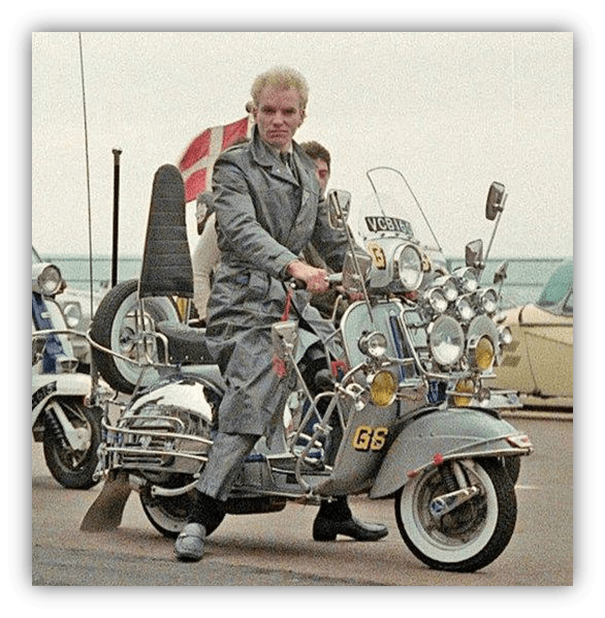
Decked out with mirrors and lights, these chrome steeds were as sharp as the tailored suits of their riders. The movie did more than just depict a subculture; it gave it a set of incredibly stylish wheels.
(And for the second time, this very article is pleased to provide another fun trivia question answer:
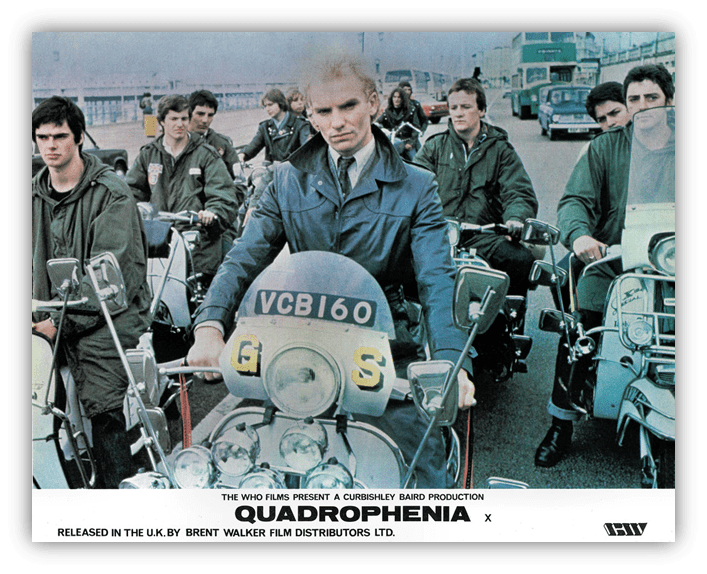
“Sting.”
You’re welcome again.
The Bluesmobile – The Blues Brothers (1980)
Now, here’s a car that truly embodied the meaning of “beater chic.”
Born from a popular Saturday Night Live sketch, The Blues Brothers movie followed the recently paroled Jake Blues and his brother Elwood on a chaotic “mission from God:”
To save their childhood orphanage. By reuniting their blues band. Naturally,
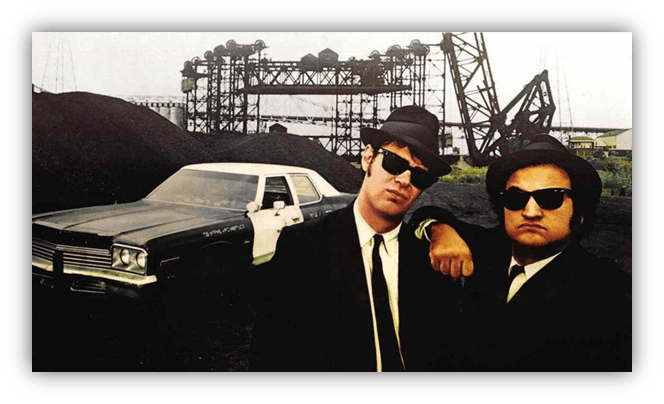
The eponymously named car was a 1974 Dodge Monaco, with the law enforcement factory-options package. It looked like it had survived a demolition derby or three. But don’t let its rough exterior fool you:
The Bluesmobile defied logic, physics, and pretty much every authority figure it encountered, jumping bridges, outsmarting Nazis (yes, really), and plowing through shopping malls with the grace of a runaway tank.
The only thing tougher than the Bluesmobile’s suspension was Jake and Elwood’s stubborn refusal to learn any song that wasn’t a blues standard.
ZZ Top’s Eliminator Coupe (1983)
Oozing Texas cool and roaring through MTV like a desert storm: Enter The Eliminator.
Coinciding with their Eliminator album, the candy apple red 1933 Ford coupe was featured heavily in several memorable music videos:
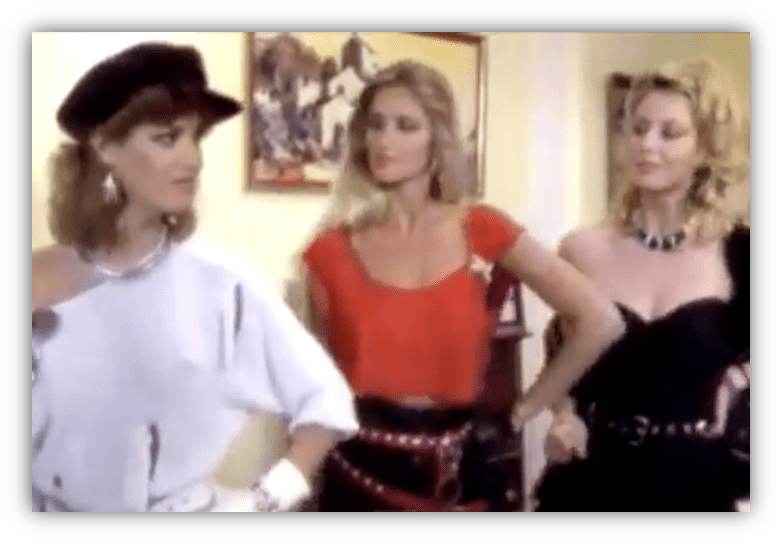
Always co-starring with a trio of stylish women, propelling the band to mainstream MTV success with memorable clips for songs like “Gimme All Your Lovin’,” “Sharp Dressed Man,” and “Legs.”
Forged in the fires of blues-rock, this classic hot rod rocker didn’t just drive; it swaggered onto the screen, leaving behind a trail of burnout marks and swooning fans.
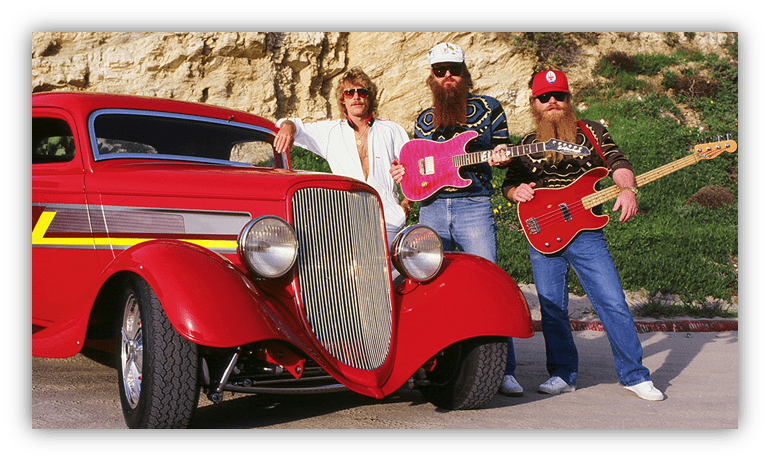
42 years later, we like to think that somewhere in Texas, The Eliminator is still cruising.
Prince’s Purple Motorcycle – Purple Rain (1984)
A custom purple motorcycle. As flamboyant and unforgettable as the artist himself.
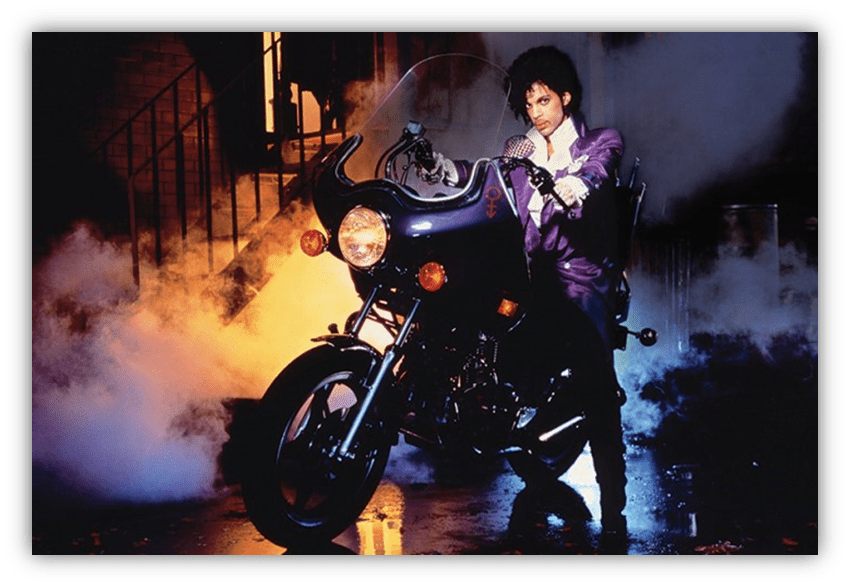
This wasn’t just transportation; it was an extension of Prince’s persona: A symbol of his mystique and raw energy.
Created for the movie Purple Rain, the customized 1981 Honda CM400 Hondamatic was notable for its purple Craig Vetter Fairing customization featuring high handlebars and passenger seat with a sissy bar.
This two-wheeled wonder somehow conveyed the musical genius of the rider.
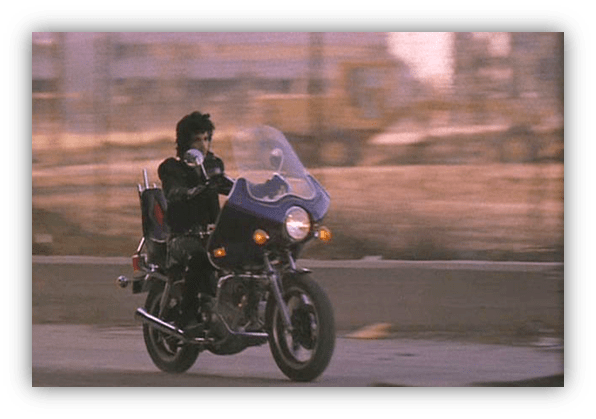
It looked like it could shred a guitar solo while popping a wheelie.
A purple blur against the Minneapolis skyline. Much like the film and the album, this motorcycle became an instant legend, forever linked to the enigmatic brilliance of its owner.
Wayne’s World Mirthmobile – Wayne’s World (1992)
A powder-blue 1976 AMC Pacer, complete with mismatched wheel covers and a licorice dispenser.
It was a perfect metaphor for Wayne and Garth’s lovable doofusness:
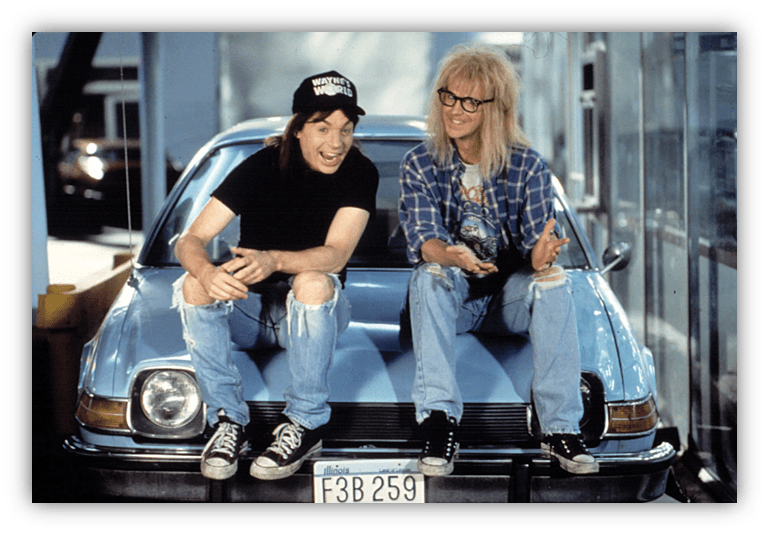
A loyal companion, accompanying the duo on their head-banging adventures.
The best party wagon that they could come up with, the Mirthmobile’s overall unusual appearance made it instantly recognizable as a visual representation of Wayne and Garth’s dork status, and general outsider vibe.
Joyously blasting Queen and transporting its occupants through the terminally suburban landscape of Aurora, Illinois? We’re not worthy.
George Clinton’s Mothership – Parliament-Funkadelic (1970s–present)
Okay, this last one’s less of a traditional vehicle and more of an… interdimensional funk delivery system.
George Clinton’s Mothership was the centerpiece stage prop used by George Clinton and his Parliament-Funkadelic crew during their live concerts. It’s a large, elaborate model of a spaceship that would “land” on stage during performances:
Often signaling the arrival of Clinton’s alter ego, Dr. Funkenstein, to “administer the funk.”
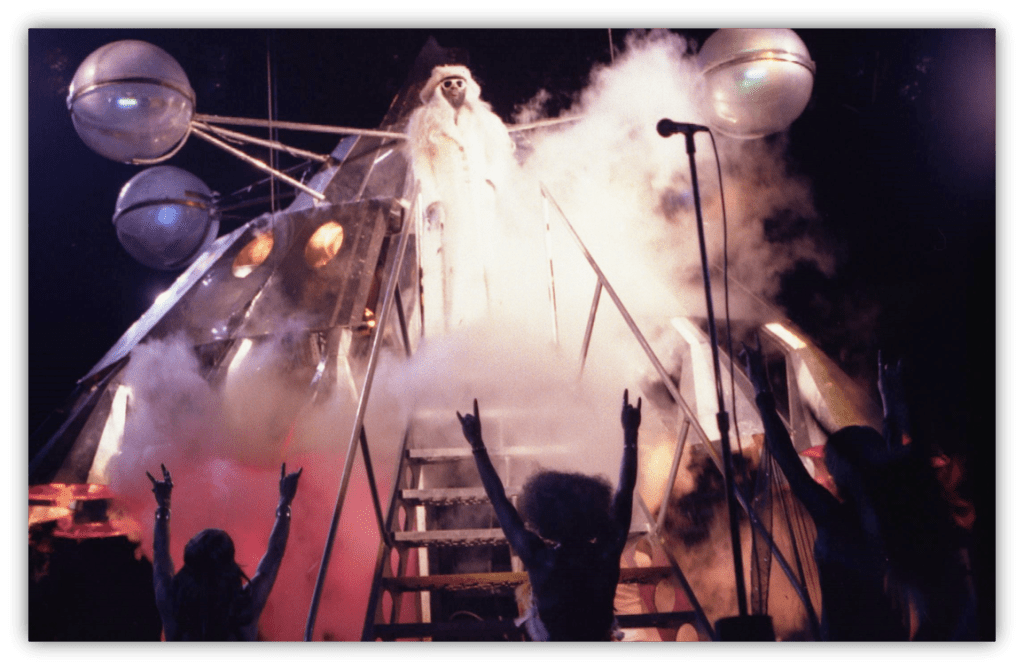
First used during a live show in 1976 at the Municipal Auditorium in New Orleans, The Mothership brings the funky gospel to the masses.

Now residing in the Smithsonian (!) it’s a testament to the power of intergalactic groove.
When the Mothership landed, it was a cosmic communion of funk. Fans were “beamed aboard” for a higher state of consciousness.
Bow wow wow yippie-oh yippie-ay, indeed.
So, there you have it: a joyride through the land of musically influenced pop culture vehicles.
They’re equal parts silly supporting characters, and canologically important pop culture iconography.
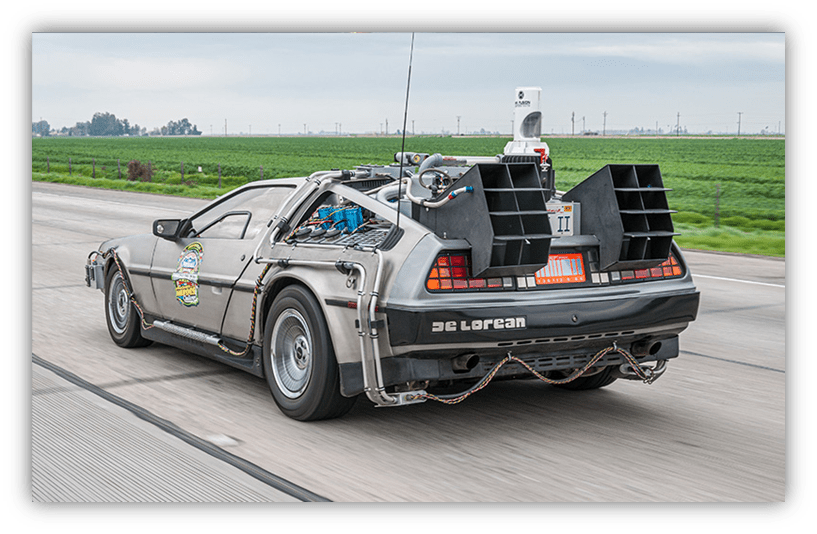
They remind us that sometimes the most memorable stars had four wheels instead of two legs.
If reincarnation is real? Let’s just hope we all come back as Prince’s motorcycle technician:
Rather than as the poor insurance adjuster who had to deal with the Bluesmobile’s claims.




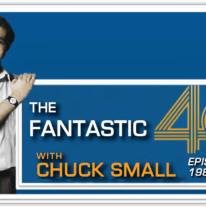
As a Who fan, I’ll add the Magic Bus as a second one for them.
Also Tommy’s glider
I watched The Monkees as a kid but I don’t remember the car. Despite it looking infinitely cool. How could I go forget that?
A couple of contributions. There’s the KLF with ‘Ford Timelord’, a 1968 Ford Galaxie police car which accompanied them through several incarnations, numerous videos and escapades. For a thorough rundown of its life there’s this; http://rustyoldrubbish.blogspot.com/2019/12/who-killed-ford-timelord.html
That’s exactly what I thought.when I saw that car. I was obsessed with weird looking racecars when I was a kid, why don’t I remember this one? Maybe I actually didn’t see The Monkees until it was on MTV later in the 90s, and not when I was a kid in the 70s.
And Super Furry Animals with their tank. Promoting their debut album they discovered it would he cheaper to buy a tank than pay for advertising across the music press. So they had it painted up, turned it into a sound system and took it round festivals through the summer of 1996. I witnessed it in action at the Phoenix Festival.
Having had their use of it they sold it onto a collector of military vehicles. A certain Don Henley. Who had it repainted to a scheme more in keeping with its original use.
With the Partridge Family bus not far behind it, my favorite of these is the Bluesmobile. Supposedly, there was a fleet of 13 decommissioned police cars from California that were used for the movie and one of them can be seen at a car museum in the tiny little town of Volo, Illinois. If you are in the Chicago area, love cars, and are willing to drive a little north, it’s worth checking out.
The Wayne’s World Mirthmobile–or at least a copy of it–showed up at the Kings Dominion Theme Park just north of Richmond, Virginia after the movie came out. I know this because I was there and saw it to my amusement. The fact that I can remember that and hardly any of the other attractions I rode that day some 30-plus years ago both scares and amazes me.
Incidentally, the Pacer has got to be one car I always looked at in the 1970s and thought, “That vehicle needs to lose weight.” AMC cars never had a great reputation for driving, which probably is what put the company under, but man, the design of the Pacer looked liked someone said, “Why don’t we take a standard station wagon and make it shorter and make like a giant was pressing his heavy thumb down on it to give it a bubble shape?” Just ugly aesthetics.
My brother drove a puke green AMC Gremlin and that car was basically embedded into my childhood. He drove it into the ground and eventually sold it for $350 as I recall. From what I understand, AMC was trying to make compact cars that could compete with the Japanese and fell woefully short.
Country legend George Jones had a drinking problem. It was so bad the his first wife starting hiding all the car keys when she left to keep him from driving to the store to get alcohol.
But that didn’t stop him. After tearing the house apart looking for a set of keys, George looked out the window to see a riding lawnmower sitting on the property under the glow of a security light. “There, gleaming in the glow, was that ten-horsepower rotary engine under a seat. A key glistening in the ignition,” George recalled in his autobiography. “I imagine the top speed for that old mower was five miles per hour. It might have taken an hour and a half or more for me to get to the liquor store, but get there I did.”
mt, is the line in the title of your article a reference to Steely Dan’s “Kid Charlemagne”?
10 piastres to rb for getting the reference.
Not to look a gift horse in the mouth, but how does that convert into U.S. dollars?
I tried to calculate, but that’s currently under review by DOGE.
I’ll try to get back to you.
I don’t know about dollars, but it’s worth about 4 pogs, or half a beanie baby, in Bartertown.
I don’t love ZZTop, but Eliminator landed at a very impressionable age for me and who can forget those videos. I always thought that car was brilliant branding for them.
Clever idea for an article–loved it!
Sorry I beat you to the punch on the Steely Dan reference, Link.
No worries! It sure looks good on you.